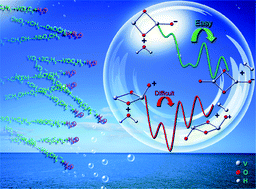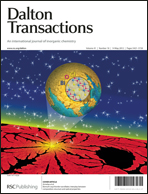Interaction of vanadium oxide cluster anions with water: an experimental and theoretical study on reactivity and mechanism†
Abstract
Vanadium oxide cluster anions (VxOy−, x = 2–3; y = 3–7) are produced by laser ablation and reacted with water in a fast flow reactor. A time-of-flight mass spectrometer is used to detect the cluster distribution before and after the reactions. Reaction channels of molecular hydrogen elimination (for V2,3O3−), water association (for V2O5− and V3O6,7−) and the coexistence of both channels (for V2O4− and V3O4,5−) are observed. V2O6− and V3O8− are nearly inert toward water. Density functional theory (DFT) calculations are performed to study the reaction mechanism of V2O3− in different spin states with water and the results support the experimental observation. The reaction mechanism of V2O3+ with water is also studied, which is in agreement with the experimental report in previous literature [Eur. J. Inorg. Chem., 2008, 4961] that molecular hydrogen elimination is a minor reaction channel for V2O3+ + H2O. The influence of cluster charge states and oxidation states of vanadium atoms on the cluster reactivity are presented based on the experimental and theoretical studies.


 Please wait while we load your content...
Please wait while we load your content...